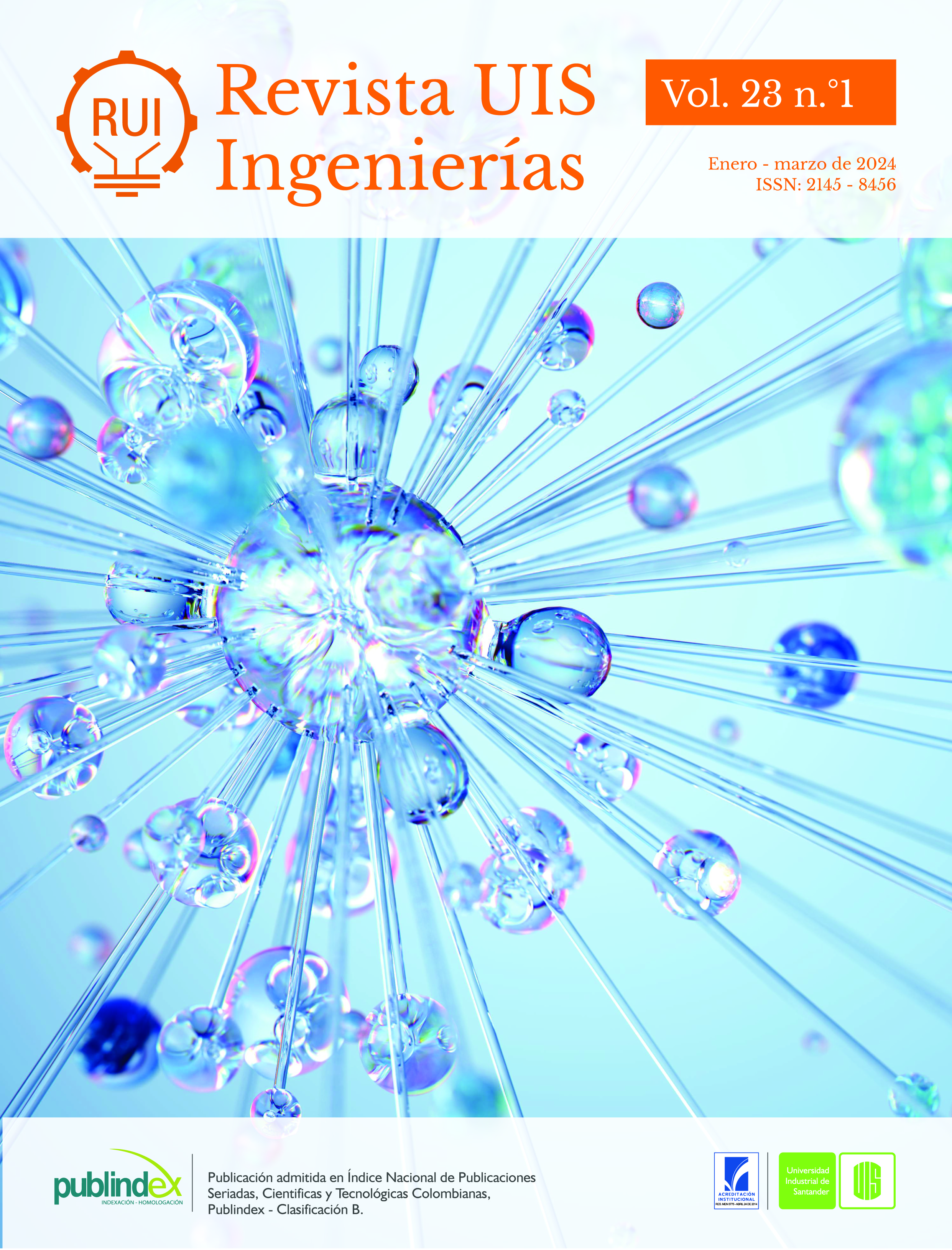Published 2024-04-08
Keywords
- Surface integrity,
- cut channel,
- hardness,
- surface roughness,
- microstructure
- cut heat affected zone,
- Comparison of cutting methods,
- Metallographic aspect,
- Cutting,
- Surface quality ...More
How to Cite
Copyright (c) 2024 Revista UIS Ingenierías

This work is licensed under a Creative Commons Attribution-NoDerivatives 4.0 International License.
Abstract
When selecting materials, different decisions must be made to choose the appropriate material according to the application, the properties of the material determine its final use, in this context, when selecting a material, the different processes to which it will be subjected before reaching its final application must be considered, because these processes can cause transformations in the different properties. In the case of steels, it must be taken into account whether the element will be subjected to any heat treatment or the method with which it will be cut, since it influences the surface properties and microstructure of the material. This article describes the study that was carried out to analyze the hardness, roughness and microstructure of the cutting channel in an ASTM-A36 steel, in a state of supply to take these values as a reference for subsequent procedures. It is proposed to cut the material with cutting methods conventionally used in the metalworking and construction industry, and also cut with other non-conventional processes used to a lesser extent in the industry. Similar cuts are made to maintain the homogeneity of the test and to analyze the cut faces in each specimen in a similar way. The specimens are cut with conventional cutting methods (milling, oxyfuel and cutting machine) and non-conventional methods (wire EDM and plasma), maintaining similar cutting and working parameters as far as possible. Subsequently, the cut surface - cutting channel - of each of the specimens is analyzed by measuring hardness, roughness and taking microscopic images of its microstructure. These tests allow quantifying the changes that occur in the material depending on the cutting method used and defining, according to each method, how much it can affect the final application of the material. When the results are obtained, comparative graphs are made between all the methods used and the differences found between them are established. From these results and comparisons, the conclusions of the study are generated.
Downloads
References
- J.A. Schey, Procesos de manufactura. México D.F: McGraw Hill, (2000).
- M. P. Groover, Fundamentos de manufactura moderna, materiales, procesos y sistemas. México D.F: Prentice Hall, 2007.
- A. Akkurt, “The effect of cutting process on surface microstructure and hardness of pure and Al 6061 aluminium alloy,” Engineering Science and Technology an International Journal, vol. 18, pp. 303–308, 2015, doi: https://doi.org/10.1016/j.jestch.2014.07.004
- A. Akkurt, “Surface properties of the cut face by different cutting methods from AISI 304 stainless steel materials,” Indian Journal of Engineering & Materials Sciences, vol. 16, pp. 373-384, 2009.
- S. N. Grigoriev, S. V. Fedorov, & K. Hamdy, “Materials, properties, manufacturing methods and cutting performance of innovative ceramic cutting tools − a review,” Manufacturing review, vol. 6, 2019, doi: https://doi.org/10.1051/mfreview/2019016
- I. Korkut, M. A. Donertas, “The influence of feed rate and cutting speed on the cutting forces, surface roughness and tool–chip contact length during face milling,” Materials in Engineering, vol. 28, pp. 308–312, 2007, doi: https://doi.org/10.1016/j.matdes.2005.06.002
- P. Muñoz-Escalona, Z. Cassier, “Influence of the critical cutting speed on the surface finish of turned steel,” Wear: An International Journal on the Science and Technology of Friction Lubrication and Wear, vol. 218, no. 1, pp. 103–109, 1998, doi: https://doi.org/10.1016/s0043-1648(98)00156-2
- R. Ghoreishi, A. H. Roohi, A. Dehghan Ghadikolaei, “Analysis of the influence of cutting parameters on surface roughness and cutting forces in high-speed face milling of Al/SiC MMC,” Materials research express, vol. 5, no. 8, 2018, doi: https://doi.org/10.1088/2053-1591/aad164
- S. Sivam, M. D. J. Bhat, N. Natarajan, “Analysis of residual stresses, thermal stresses, cutting forces and other output responses of face milling operation on ZE41 Magnesium alloy,” Int. J. Modern Manuf. Tech, vol. 10, no. 1, pp.92–100, 2018.
- Acero estructural ASTM A-36. Disponible en: http://www.cga.com.co/productos-y-servicios/productos/laminas-y-planchas-de-acero.
- S. M. Alsoufi, D. K. Suker, A. S. Alsabban, S. Azam, “Experimental Study of Surface Roughness and Micro-Hardness Obtained by Cutting Carbon Steel with Abrasive WaterJet and Laser Beam Technologies,” American Journal of Mechanical Engineering, vol. 4, no. 5, no. 173–181, 2016, doi: https://doi.org/10.12691/ajme-4-5-2
- J. Aldazabal, A. Martín-Meizoso, A. Klimpel, A. Bannister, S. Cicero, “Mechanical and microstructural features of plasma cut edges in a 15 mm thick S460M steel plate,” Metals, 2018, doi: https://doi.org/10.3390/met8060447
- I. Peko, P. Ljumović, B. Nedić, M. Dunđer, “Analysis of the heat affected zone in plasma jet cutting process of the aluminium alloy EN AW 5083,” Zastita Materijala, vol. 60, no. 2, pp. 174–181, 2019, https://doi.org/10.5937/zasmat1902174p
- P. Tian, L. He, T. Zhou, F. Du, Z. Zou, X. Zhou, H. Jiang, “Effect of workpiece microstructure on tool wear behavior and surface quality during machining Inconel 718 alloy,” Tribology International, 2022, doi: https://doi.org/10.1016/j.triboint.2022.107814
- P. Hoier, A. Malakizadi, S. Friebe, U. Klement, P. Krajnik, “Microstructural variations in 316L austenitic stainless steel and their influence on tool wear in machining,” Wear: An International Journal on the Science and Technology of Friction Lubrication and Wear, pp. 315–327. 2019, doi: https://doi.org/10.1016/j.wear.2019.02.024
- J. Górka, T. Poloczek, “The influence of thermal cutting on the properties and quality of the cut surfaces toughened steel S 960QL,” IOP conference series: Materials science and engineering, 2018, doi: https://doi.org/10.1088/1757-899x/400/2/022032
- A. Suárez, F. Veiga, R. Polvorosa, T. Artaza, J. Holmberg, L. N. de Lacalle, A. Wretland, “Surface integrity and fatigue of non-conventional machined Alloy 718,” Journal of Manufacturing Processes, vol. 48, pp. 44–50, 2019, doi: https://doi.org/10.1016/j.jmapro.2019.09.041

